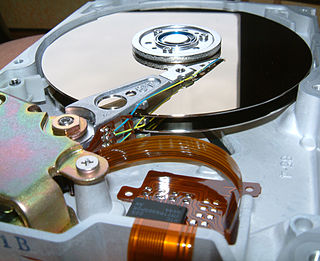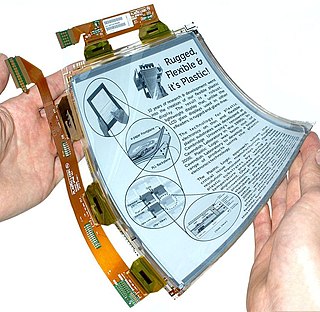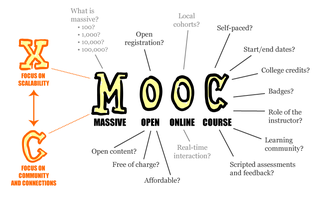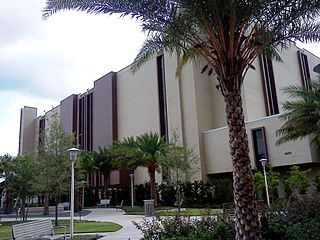Related Research Articles
Distance education, also known as distance learning, is the education of students who may not always be physically present at school, or where the learner and the teacher are separated in both time and distance. Traditionally, this usually involved correspondence courses wherein the student corresponded with the school via mail. Distance education is a technology-mediated modality and has evolved with the evolution of technologies such as video conferencing, TV, and the Internet. Today, it usually involves online education and the learning is usually mediated by some form of technology. A distance learning program can either be completely a remote learning, or a combination of both online learning and traditional offline classroom instruction. Other modalities include distance learning with complementary virtual environment or teaching in virtual environment (e-learning).

A personal digital assistant (PDA), also known as a handheld PC, is a multi-purpose mobile device which functions as a personal information manager. PDAs have been mostly displaced by the widespread adoption of highly capable smartphones, in particular those based on iOS and Android, and thus saw a rapid decline in use after 2007.

In mass communication, digital media is any communication media that operates in conjunction with various encoded machine-readable data formats. Digital content can be created, viewed, distributed, modified, listened to, and preserved on a digital electronic device, including digital data storage media and digital broadcasting. Digital is defined as any data represented by a series of digits, and media refers to methods of broadcasting or communicating this information. Together, digital media refers to mediums of digitized information broadcast through a screen and/or a speaker. This also includes text, audio, video, and graphics that are transmitted over the internet for viewing or listening to on the internet.
Electronic publishing includes the digital publication of e-books, digital magazines, and the development of digital libraries and catalogues. It also includes the editing of books, journals, and magazines to be posted on a screen.

A textbook is a book containing a comprehensive compilation of content in a branch of study with the intention of explaining it. Textbooks are produced to meet the needs of educators, usually at educational institutions. Schoolbooks are textbooks and other books used in schools. Today, many textbooks are published in both print and digital formats.
Blended learning or hybrid learning, also known as technology-mediated instruction, web-enhanced instruction, or mixed-mode instruction, is an approach to education that combines online educational materials and opportunities for interaction online with physical place-based classroom methods.
M-learning, or mobile learning, is a form of distance education where learners use portable devices such as mobile phones to learn anywhere and anytime. The portability that mobile devices provide allows for learning anywhere, hence the term "mobile" in "mobile learning." M-learning devices include computers, MP3 players, mobile phones, and tablets. M-learning can be an important part of informal learning.

Open educational resources (OER) are teaching, learning, and research materials intentionally created and licensed to be free for the end user to own, share, and in most cases, modify. The term "OER" describes publicly accessible materials and resources for any user to use, re-mix, improve, and redistribute under some licenses. These are designed to reduce accessibility barriers by implementing best practices in teaching and to be adapted for local unique contexts.
Educational technology is the combined use of computer hardware, software, and educational theory and practice to facilitate learning. When referred to with its abbreviation, "EdTech," it often refers to the industry of companies that create educational technology. In EdTech Inc.: Selling, Automating and Globalizing Higher Education in the Digital Age, Tanner Mirrlees and Shahid Alvi (2019) argue "EdTech is no exception to industry ownership and market rules" and "define the EdTech industries as all the privately owned companies currently involved in the financing, production and distribution of commercial hardware, software, cultural goods, services and platforms for the educational market with the goal of turning a profit. Many of these companies are US-based and rapidly expanding into educational markets across North America, and increasingly growing all over the world."
In the context of education, one-to-one computing refers to academic institutions, such as schools or colleges, that allow each enrolled student to use an electronic device in order to access the Internet, digital course materials, and digital textbooks. The concept has been actively explored and sporadically implemented since the late 1990s. One-to-one computing used to be contrasted with a policy of "bring your own device" (BYOD), which encourages or requires students to use their own laptops, smartphones or other electronic devices in class. The distinction between BYOD and school-issued devices became blurred when many schools started recommending devices for parents to buy. The term 1:1 computing in education is now redefined to a situation where students have access to a device per individual that is used in the teaching as a tool for learning. Historically, the programs have centered around the following devices:

Plastic Logic Germany develops and manufactures electrophoretic displays (EPD), based on organic thin-film transistor (OTFT) technology, in Dresden, Germany.
An open textbook is a textbook licensed under an open license, and made available online to be freely used by students, teachers and members of the public. Many open textbooks are distributed in either print, e-book, or audio formats that may be downloaded or purchased at little or no cost.

The CK-12 Foundation is a California-based non-profit organization which aims to increase access to low-cost K-12 education in the United States and abroad. CK-12 provides free and customizable K-12 open educational resources aligned to state curriculum standards. As of 2022, the foundation's tools were used by over 200,000,000 students worldwide.

An ebook, also known as an e-book or eBook, is a book publication made available in electronic form, consisting of text, images, or both, readable on the flat-panel display of computers or other electronic devices. Although sometimes defined as "an electronic version of a printed book", some e-books exist without a printed equivalent. E-books can be read on dedicated e-reader devices, also on any computer device that features a controllable viewing screen, including desktop computers, laptops, tablets and smartphones.

A massive open online course or an open online course is an online course aimed at unlimited participation and open access via the Web. In addition to traditional course materials, such as filmed lectures, readings, and problem sets, many MOOCs provide interactive courses with user forums or social media discussions to support community interactions among students, professors, and teaching assistants (TAs), as well as immediate feedback to quick quizzes and assignments. MOOCs are a widely researched development in distance education, first introduced in 2008, that emerged as a popular mode of learning in 2012, a year called the "Year of the MOOC".

The Barnes & Noble Nook is a brand of e-readers developed by American book retailer Barnes & Noble, based on the Android platform. The original device was announced in the U.S. in October 2009, and was released the next month. The original Nook had a six-inch E-paper display and a separate, smaller color touchscreen that serves as the primary input device and was capable of Wi-Fi and AT&T 3G wireless connectivity. The original Nook was followed in November 2010 by a color LCD device called the Nook Color, in June 2011 by the Nook Simple Touch, and in November 2011 and February 2012 by the Nook Tablet. On April 30, 2012, Barnes & Noble entered into a partnership with Microsoft that spun off the Nook and college businesses into a subsidiary. On August 28, 2012, Barnes and Noble announced partnerships with retailers in the UK, which began offering the Nook digital products in October 2012. In December 2014, B&N purchased Microsoft's Nook shares, ending the partnership.
Bring your own device —also called bring your own technology (BYOT), bring your own phone (BYOP), and bring your own personal computer (BYOPC)—refers to being allowed to use one's personally owned device, rather than being required to use an officially provided device.
Open Course Library (OCL) is an effort by the State of Washington to identify and make available digitally, to community and technical college instructors and students across that state, free textbooks, interactive assignments, and videos. Instructional materials can be "a smorgasbord of teaching modules and exercises developed by other open-learning projects.. . Interactive-learning Web sites and even instructional videos on YouTube. . ." However, OCL is not an OER publishing project, although it did contribute to the development of some widely used resources. Goals include: lowering textbook costs for students, providing new resources for faculty to use in their courses; and fully engaging in the global OER or open educational resources discussion.
Social media in education is the practice of using social media platforms or technology to enhance the education of students. Social media is "a group of Internet-based applications that build on the ideological and technological foundations of Web 2.0, and that allow the creation and exchange of user-generated content". Social media platforms can be used to complete assignments or projects electronically. Students can benefit from engaging in activities that involve the use of computers and online platforms, as these opportunities can help them develop their skills in these areas.

The University of South Florida Tampa Library is the main research library for the University of South Florida. Housing over 1.3 million books, academic journals and electronic resources, including 52,000 e-journal subscriptions, 443,000 e-books, and over 800 databases, the library has more than 2 million visitors each year. The library offers tutoring and writing services, laptops, a career resource center, and course reserves. The facility houses several special and digital collections, including literature, oral histories, photographs, artifacts, and the university archives. The current Dean of USF Libraries is Todd Chavez.
References
- ↑ Reckelhoff, Benjamin (2021-02-18). "How eTextbooks Work". ecampus.com. Archived from the original on 2016-06-29.
- ↑ Creno, Cathryn (17 March 2014). "Online e-books replace heavy school textbooks". AZ Central. Archived from the original on 18 March 2014. Retrieved 17 March 2014.
- ↑ Haq, Husna (6 July 2011). "In South Korea, all textbooks will be e-books by 2015". Christian Science Monitor. Archived from the original on 18 March 2014. Retrieved 17 March 2014.
- ↑ Toppo, Greg (31 January 2012). "Obama wants schools to speed digital transition". USA Today. Archived from the original on 18 March 2014. Retrieved 17 March 2014.
- ↑ Grossman, Sara (17 July 2013). "Students prefer print for serious academic reading". Christian Science Monitor. Archived from the original on 18 March 2014. Retrieved 17 March 2014.
- ↑ Howard, Jennifer (27 January 2013). "For many students, print is still king". Chronicle of Higher Education. Archived from the original on 31 October 2013. Retrieved 17 March 2014.
- ↑ Heussner, Ki Mae (22 October 2012). "In digital textbook transition, device availability is just the beginning". Gigaom. Archived from the original on 18 March 2014. Retrieved 17 March 2014.
- ↑ Ritch, Emma (2009). "The environmental impact of Amazon's Kindle". Archived from the original on 2021-02-21.
- ↑ Reckelhoff, Benjamin (2021-03-05). "About VitalSource". VitalSource. Archived from the original on 2021-02-27.
- ↑ Courduff, Susan (2011). "Digital textbooks and students with special needs". TeachingHistory.org roundtable: digital textbooks: has their time come?. TeachingHistory.org. Archived from the original on 24 March 2014. Retrieved 23 March 2014.
The inclusive nature of digital textbooks has the potential to powerfully meet the diverse learning needs of students who are exceptional.
- ↑ Blume, Howard (19 November 2013). "iPad software licenses expire in three years, L.A. Unified says". Los Angeles Times. Archived from the original on 29 March 2014. Retrieved 18 March 2014.
- ↑ Greenfield, Jeremy (11 June 2013). "Students, [rofessors still not yet ready for digital textbooks". Digital Book World. Archived from the original on 19 March 2014. Retrieved 18 March 2014.
- ↑ "The reasons young people aren't buying ebooks". Booktrade.info. 16 March 2014. Archived from the original on 19 March 2014. Retrieved 18 March 2014.
- ↑ McNeish, Joanne; Mary Foster; Anthony Francescucci; Bettina West (Fall 2012). "The surprising foil to online education: why students won't give up paper textbooks" (PDF). Journal for the Advancement of Marketing Education. 20 (3). Archived from the original (PDF) on 28 February 2013. Retrieved 18 March 2014.
- ↑ Jabr, Ferris (11 April 2013). "The reading brain in the digital age: the science of paper vs. screens". Scientific American. Archived from the original on 19 March 2014. Retrieved 18 March 2014.
Research suggests that reading on paper still boasts unique advantages.
- ↑ "Student response to digital textbooks climbs, says new BISG research". Bowker Market Research. 25 January 2013. Archived from the original on 9 February 2014. Retrieved 23 March 2014.
- ↑ Sicking, Jennifer (6 May 2013). "Research shows students perform well regardless of reading print or digital books". Archived from the original on 19 March 2014. Retrieved 18 March 2014.